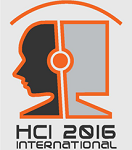Toronto, Canada, 17 - 22 July 2016
The Westin Harbour Castle Hotel
Monday, 18 July 2016, 09:00 - 12:30
Aaron Marcus (short bio)
Aaron Marcus and Associates (AM+A), Berkeley, California, United States
Objectives:
Participants in this course will:
- Understand how science-fiction movies and television have/have not incorporated fundamental principles of user-centered design to achieve usability, usefulness, and appeal
- Understand the development of science-fiction in the popular media over the past 100 years
- Understand how to apply their professional knowledge to look at popular media
Participants should be generally familiar with user-interface development steps (planning, research, analysis, design, evaluation, implementation, documentation, training) and user-interface components (metaphors, mental models, navigation, interaction, and experience), but may have little or no experience in science-fiction or the history of movies and television
Participants can use their knowledge of user-experience design, interaction design, visual design, software/hardware engineering, ethnography, anthropology, and usabilty analysis to find new insights in this course in new ways to apply their expertise and experience.
Concepts covered to assist professionals to design more effectively are these:
- User Analysis: Specification of user demographics and user-environment, user modeling, task analysis, and accounting for business objectives
- Metaphors: Easy recognized and remembered, fundamental conceptsconveyed through words, signs, and images
- Mental models: Appropriate organization of data, functions, tasks, roles,and people
- Navigation of mental model: Efficient movement within the mental model via windows, menus, dialogue boxes, or control panels
- Interaction: Effective input and output-feedback sequencing
- Appearance: Quality visual, acoustic, and touch characteristics
- Information Visualization: Tables, charts, maps, and diagrams
- Basic visual design: Scale, proportion, rhythm, symmetry, and balance
- Cross-cultural communication
- User-centered design process
Content and Benefits:
This tutorial will summarize and analyze the past 100 years of human-computer interaction (HCI) and user-experience (UX) as incorporated into science-fiction movies and television, beginning with the advent of movies in the early 1900s (Melies' "A Trip to the Moon," which was later referenced in the movie "Hugo") and concluding with the latest movies. For many decades movies have shown technology in advance of its commercialization (for example, video phones and wall-sized television displays, hand-gesture systems, and virtual reality displays). In some cases mistaken views about what is usable, useful, and appealing seem to be adopted, perhaps because of their cinematic benefits. In any case, these media have served as informal "test-beds" for new technologies of human-computer interaction and communication. They provide ample evidence for heuristic evaluations, ethnographic enalysis, market analysis, critique of personas and use scenarios, and new approaches to conceptual and visual design.
The course will explore issues of what is "futuristic" and what is not, gender-role differences, optimism/pessimism, and user-centered design characteristics in more than two dozen films and a half-dozen television shows. Examples from China, India, and Japan will also be referenced.
Participants will be informally quizzed about their recognition of the media examples shown and their analysis of contexts, technologies, business models, user communities, and designs. Discussion with participants throughout the presentation will be encouraged., Participants in this course will understand how science-fiction movies and television have/have not incorporated fundamental principles of user-centered design to achieve usability, usefulness, and appeal; understand the development of science-fiction in the popular media over the past 100 years; and understand better how to apply their professional knowledge to look at popular media
Detailed Description and Allocation of Time:
Lecture 0: Introduction to instructor and tutorial (15 minutes)
Introduces the schedule, objectives, and speaker’s credentials.
Lectures 1: The Past 100 Years of the Future: CHI/HCI/UX in Science-Fiction Movies and Televison (180 minutes)
This lecture introduces key terminology and concepts regarding the user-interface design/user-experience design, science-fiction narratives, and discusses the history of science-fiction movies and television.
Bio Sketch of Presenter:

Mr. Marcus has been a life-long fan of science-fiction novels, magazines, movies, and television shows. He organized two Sci-Fi panels at CHI conferences in 1992 and 1999. He edited a special issue of UX magazine on the subject of UX in Sci-Fi. He has given keynote lectures about UX in Sci-Fi in the USA, China, and Europe. He has published: The Past 100 Years of the Future: UX in Sci-Fi Movies and Television (2012).
Mr. Marcus has been researching and designing user-experiences since 1969. He received a BA in Physics from Princeton University (1965) and a BFA and MFA in Graphic Design from Yale University School of Art and Architecture (1968). He is an internationally recognized authority on the design of user interfaces, interactive multimedia, and printing/publishing documents. Mr. Marcus has given tutorials at HCII, SIGGRAPH, SIGCHI, HFES, UXPA and other conferences, and at seminars for businesses and academic institutions around the world. He published 23 books and more than 300 articles, including Human Factors and Typography for More Readable Programs (1990), The Cross-GUI Handbook (1994), Mobile TV: Customizing Content and Context (2010), Graphic Design for Electronic Documents and User Interfaces (1992), The Past 100 Years of the Future: UX in Sci-Fi Movies and Television (2012), Mobile Persuasion Design (2015), and HCI/User-Experience Design: Fast Forward to the Past, Present, and Future (2015). Mr. Marcus was the world’s first professional graphic designer to be involved full-time in computer graphics (1967), to program a desktop publishing system (for the AT&T Picturephone, 1969-71), to design virtual realities (1971-73), and to establish an independent computer-based user-interface and information-visualization firm (1982). In 1992, he received the National Computer Graphics Association Industry Achievement Award for contributions to computer graphics. In 2008, the AIGA named him a Fellow; in 2009, CHI elected him to the CHI Academy. He is a Visiting Professor, Institute of Design, IIT, Chicago, and College of Design and Innovation, Tongji University, Shanghai.
Mr. Marcus is Principal of Aaron Marcus and Associates, a user-interface and information-visualization development firm with more than 34 years of experience in helping people make smarter decisions faster, at work, at home, at play, and on the way. AM+A), has developed user-centered, task-oriented solutions for complex computer-based design and communication challenges for clients worldwide on all major platforms (client-server networks, the Web, mobile devices, appliances, and vehicles), for most vertical markets, and for most user communities within companies and among their customers. AM+A has served corporate, government, education, and consumer-oriented clients to meet their needs for usable products and services with proven improvements in readability, comprehension, and appeal. AM+A uses its well-established methodology to help them plan, research, analyze, design, implement, evaluate, train, and document metaphors, mental models, navigation, interaction and appearance. AM+A has developed ten concept designs for mobile persuasion design, documented in Mobile Persuasion Design (2015). AM+A’s mobile-oriented clients include BMW, DaimlerChrysler, HP, Microsoft, Motorola, Nokia, Sabre, Samsung, SAP, and Siemens.



